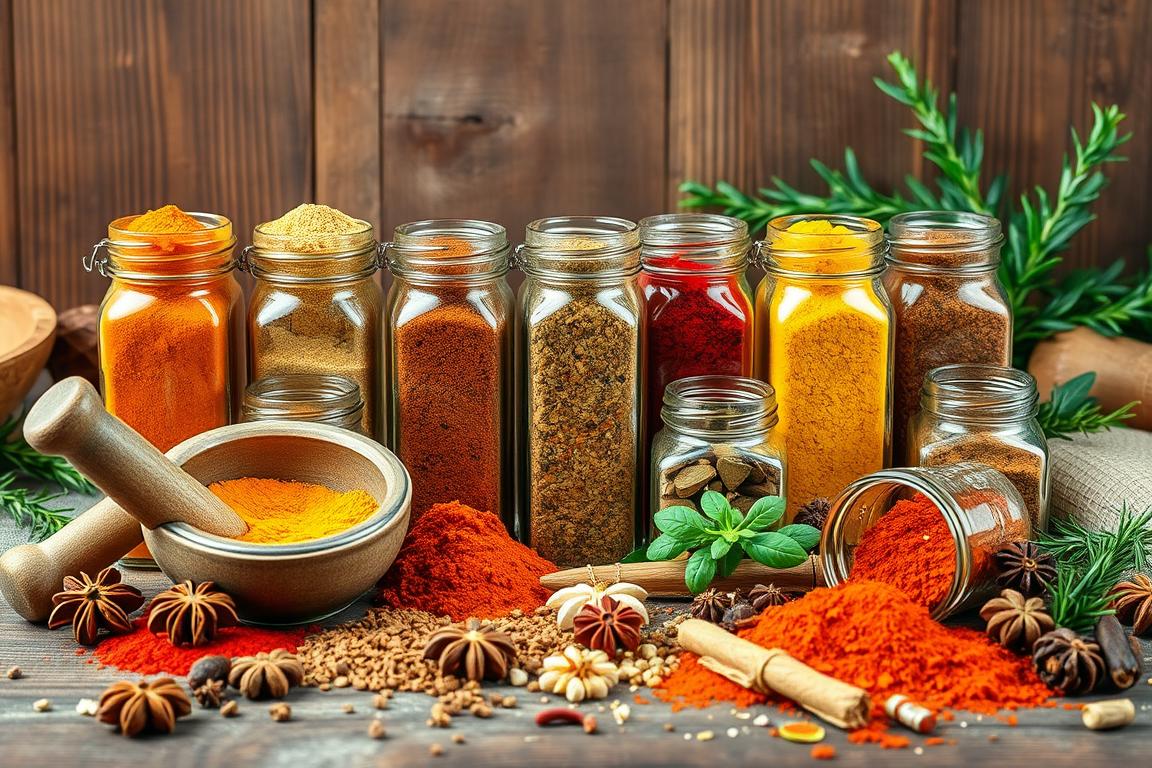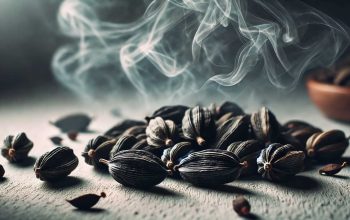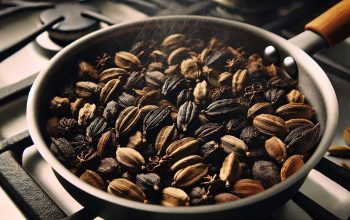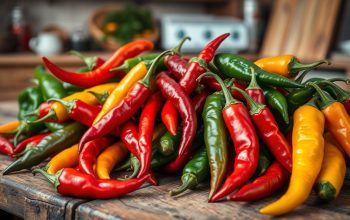Spices are key to making great food. They turn simple dishes into amazing flavors. If you’re new to cooking or want to improve, having a good spice collection is important. This guide will help you learn about Spice Essentials, Culinary Seasonings, and Flavor Enhancers. You’ll be able to make tasty meals with ease.
Whether you’re an expert chef or a home cook, a good spice collection can make your cooking better. You’ll learn about the health benefits of fresh spices and how to save money by making your own seasonings. This guide will give you the skills to build a spice collection that will help you explore new recipes.
Get ready for a flavorful adventure. We’ll cover the must-have spices, how to store them, and how to measure them. You’ll also learn about creative spice blends. Your kitchen will become a place of culinary wonder. Impress your loved ones with your new spice skills and open up a world of cooking possibilities.
Understanding the Importance of a Well-Stocked Spice Pantry
Having a wide range of Herbs and Spices is key for any home cook. It helps you improve your cooking and explore new flavors. Aromatics like garlic, ginger, and onions are the base for many dishes. A good spice cabinet can turn simple ingredients into amazing meals.
Health Benefits of Cooking with Fresh Spices
Herbs and Spices do more than just add taste. They are full of antioxidants and anti-inflammatory compounds. Adding fresh Aromatics to your cooking can make your meals healthier and tastier.
Cost-Effectiveness of Home Seasoning
Having your own Herbs and Spices can also save you money. Store-bought spice mixes can be pricey. But making your own blends lets you control the ingredients and save money on seasoning.
| Herb or Spice | Health Benefits | Culinary Uses |
|---|---|---|
| Turmeric | Anti-inflammatory, antioxidant | Curries, rice dishes, marinades |
| Cinnamon | Blood sugar regulation, anti-microbial | Baked goods, hot beverages, savory dishes |
| Ginger | Digestive aid, anti-nausea | Stir-fries, teas, baked goods |
Learning about Herbs and Spices can change your cooking. It makes your meals more flavorful, nutritious, and affordable.
“The secret of good cooking is not just in the ingredients, but in the spices.”
Essential Tools for Spice Storage and Preparation
Having a good spice pantry is more than just jars and bottles. The right Spice Grinders and Spice Racks make cooking better. They keep your spices fresh and strong.
For storage, airtight containers are key. Glass jars or tins with tight lids keep flavors in. Choose containers that block UV light to protect your spices.
- Get a top-notch Spice Grinder for fresh spice powder. It keeps oils in and makes food taste better.
- Use a Spice Rack to keep spices organized. It makes finding what you need easy and keeps spices from getting lost.
- Don’t forget measuring spoons. They help you season dishes right, so flavors are always consistent.
With the right tools, your kitchen can make the most of your spices. Your dishes will have bold, vibrant flavors.
“The secret of good cooking is not just in the ingredients, but in the tools you use to bring those ingredients together.”
Basic Must-Have Spices for Every Kitchen
Having the right Spice Essentials and Culinary Seasonings in your kitchen is key. It’s important for beginners to know the essential spices every home cook needs. These spices help make dishes flavorful and balanced.
Ground vs. Whole Spices
There are ground and whole spice options. Ground spices are easy to use, while whole spices offer deeper flavors. It’s good to have both for different cooking needs.
Storage Life and Freshness Tips
Keeping spices fresh is crucial. Store them in airtight containers, away from sunlight and heat. Ground spices last 6 months to a year. Whole spices can last 2-3 years if stored right.
Quantity Guidelines for Beginners
- Begin with 2-4 ounces of each Spice Essential to use them before they expire.
- Focus on spices like black pepper, garlic powder, onion powder, and dried herbs.
- Grow your spice collection as you learn new recipes and flavors.
| Spice Essential | Ground vs. Whole | Shelf Life | Quantity Recommendation |
|---|---|---|---|
| Black Pepper | Both | 6 months – 2 years | 2-4 ounces |
| Garlic Powder | Ground | 6 months – 1 year | 2-4 ounces |
| Onion Powder | Ground | 6 months – 1 year | 2-4 ounces |
| Dried Basil | Ground | 6 months – 1 year | 1-2 ounces |
| Dried Oregano | Ground | 6 months – 1 year | 1-2 ounces |
With these Spice Essentials and Culinary Seasonings, you’ll make delicious meals easily.
Mediterranean Spice Essentials
Discover the lively tastes of Mediterranean food with a great spice collection. Essential Spices like oregano, basil, rosemary, and thyme are key for many classic dishes. They make every meal more flavorful and aromatic.
Oregano adds an earthy, minty taste to Italian and Greek dishes. It’s great in sauces, pizza, and grilled meats. Basil, with its sweet, peppery flavor, is perfect with tomatoes, olive oil, and mozzarella in caprese salads and pesto.
Rosemary has a pine-like scent and is great for roasted veggies, potatoes, and lamb. Thyme, with its subtle lemony taste, goes well in soups, stews, grilled fish, and poultry.
Having these Ethnic Spices is key to making Mediterranean dishes shine. They’ll make your cooking taste like a trip to the Mediterranean.
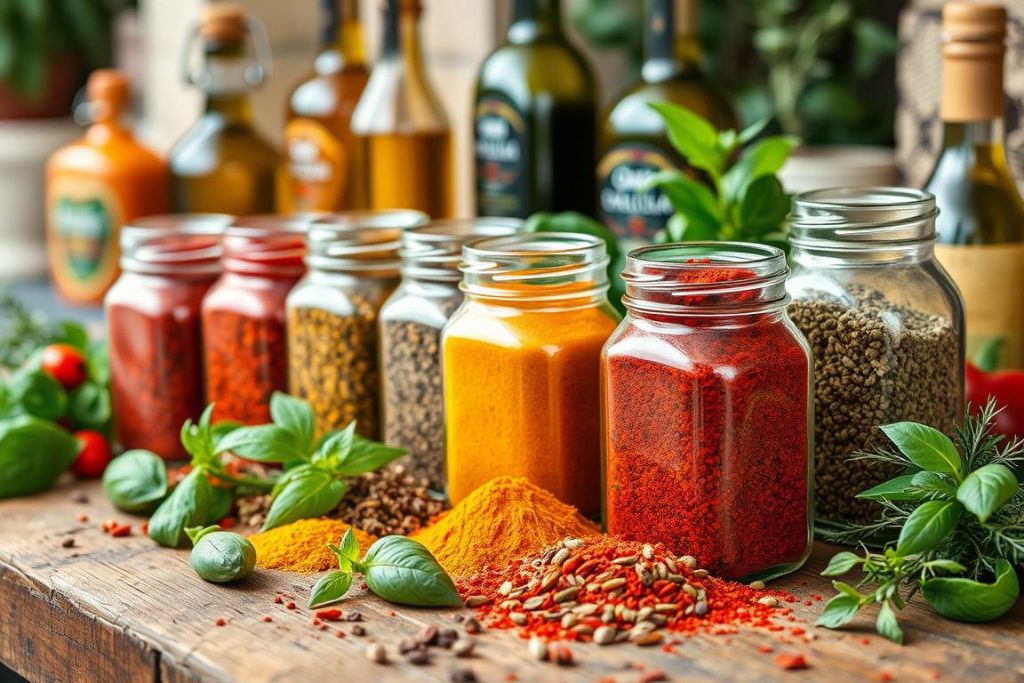
“The secret to great Mediterranean cooking lies in the careful selection and combination of aromatic Flavor Enhancers.”
Asian Spice Cabinet Fundamentals
The Asian spice cabinet is a treasure trove of Aromatics. These spices add depth and complexity to many cuisines. From East Asia’s vibrant flavors to South Asia’s soulful spices, knowing these blends is essential.
East Asian Spice Selection
In East Asia, a few Ethnic Spices are key. Ginger, garlic, and soy sauce are the holy trinity. They add savory notes to stir-fries, marinades, and sauces.
Star anise, fennel, and cinnamon are also crucial. They come together in Chinese five-spice powder. This blend adds warmth and fragrance to braised dishes and roasted meats.
South Asian Spice Staples
The Indian subcontinent has a rich array of Ethnic Spices. Turmeric, cumin, and coriander are the holy trinity here. They add distinct flavors and vibrant hues to curries, dals, and biryanis.
Cardamom, cloves, and black pepper add depth and warmth. Chili peppers bring the characteristic heat to many South Asian dishes.
| East Asian Spices | South Asian Spices |
|---|---|
| Ginger, Garlic, Soy Sauce | Turmeric, Cumin, Coriander |
| Star Anise, Fennel, Cinnamon | Cardamom, Cloves, Black Pepper |
| Chinese Five-Spice Powder | Chili Peppers |
“The true essence of Asian cuisine lies in the skillful blending of Ethnic Spices, which transforms the mundane into the extraordinary.”
Understanding Spice Measurements and Proportions
Mastering spice measurements is key to seasoning your dishes right. Whether you’re making Seasoning Mixes or trying out Culinary Seasonings, the right spice balance is crucial. It can elevate your dish’s flavors.
Remember, a little spice is enough. Start with 1/4 to 1/2 teaspoon per serving. Then, you can add more to taste. This way, you can adjust the seasoning without overpowering your dish.
| Spice | Typical Measurement |
|---|---|
| Ground Spices (e.g., cumin, coriander, chili powder) | 1/4 to 1 teaspoon per serving |
| Whole Spices (e.g., peppercorns, cinnamon sticks, cloves) | 1/2 to 2 teaspoons per serving |
| Dried Herbs (e.g., thyme, rosemary, oregano) | 1/2 to 1 teaspoon per serving |
For spice blends, aim for a balanced flavor mix. Use equal parts of main spices and smaller amounts of strong ones like cayenne. Try different mixes to find what you like best.
“Spices are the soul of Indian cuisine, and the perfect blend can transform a dish from ordinary to extraordinary.”
As you get better at using spices, learn to adjust seasoning levels instinctively. Taste as you go and make small changes until you get the flavor you want.
Creating Your Own Spice Blends at Home
Are you tired of using the same Spice Blends and Seasoning Mixes from the store? It’s time to get creative and make your own spice mixes. This not only fun but also lets you customize flavors to your liking.
Popular Blend Recipes
Begin by trying out some classic spice blends. Garam Masala, a fragrant Indian mix, combines cumin, coriander, cardamom, and cinnamon. Herbes de Provence, a French favorite, blends thyme, rosemary, savory, and lavender. Feel free to play with these recipes and add your own twist.
Mixing and Storage Techniques
- When making your own Spice Blends, focus on the spice ratios. Start small to get the flavor just right.
- Keep your homemade Seasoning Mixes in airtight containers, away from light and heat. This keeps them fresh and potent.
- Think about getting a good spice grinder or mortar and pestle. They help you grind spices to the perfect texture.
“Making your own spice blends at home is a game-changer. It lets you create complex, nuanced flavors that you can’t find in store-bought mixes.”
Get into the world of homemade Spice Blends and Seasoning Mixes to take your cooking to the next level. With a bit of experimentation and some key tips, you’ll be making custom spice mixes that will wow your guests.
Herbs vs Spices: Understanding the Difference
The difference between Herbs and Spices is quite interesting. These two are key in cooking, adding depth and complexity to our food. They are the foundation of Aromatics that excite our senses.
Herbs come from the leafy parts of plants and have a fresh, vibrant taste. They enhance food flavors, adding a green and earthy touch. Basil, Thyme, Rosemary, and Cilantro are examples that make meals special.
Spices, on the other hand, are from dried seeds, roots, bark, or berries. They have a stronger, more concentrated flavor. Spices add depth and warmth to dishes, like Cinnamon, Cumin, and Chili Powder.
| Herbs | Spices |
|---|---|
| Derived from the leafy parts of plants | Derived from the dried seeds, roots, bark, or berries of plants |
| Offer a fresh, vibrant, and delicate flavor profile | Tend to have a more robust, concentrated, and sometimes pungent taste |
| Examples: Basil, Thyme, Rosemary, Cilantro | Examples: Cinnamon, Cumin, Chili Powder |
The mix of Herbs and Spices makes food truly special. Knowing their unique qualities helps us blend them for amazing flavors. For example, Thyme and Cumin make a stew richer, while Basil and Lemon Pepper brighten a summer salad.
“The art of cooking lies not merely in the ingredients, but in the careful balance and interplay of Herbs and Spices.”
Exploring Herbs and Spices opens up a world of flavors. As you cook, try new combinations to find the perfect taste for you.
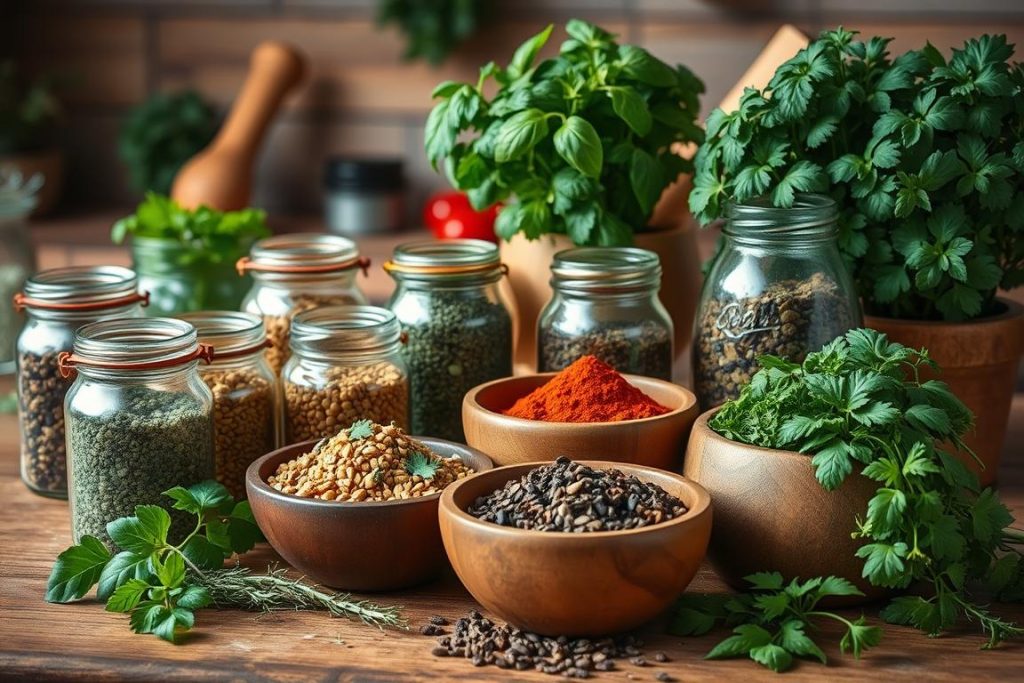
Best Practices for Spice Storage and Organization
Keeping your Spice Essentials fresh and potent is key to enjoying your cooking. Simple storage and organization tips for Spice Racks can help. This way, your spices will stay vibrant and flavorful for a longer time.
Temperature and Light Considerations
Spices do best in cool, dark places. Don’t store them near heat sources like stoves or ovens. Also, keep them away from direct sunlight. The best storage temperature is between 65-75°F.
Think about getting a special spice cabinet or drawer. This will protect your Spice Essentials from temperature changes and bright light.
Container Types and Materials
- Glass jars or bottles are great for Spice Racks because they block light and seal well.
- Use opaque containers, like ceramic or tinted glass, to keep spices away from light.
- Don’t store spices in plastic bags or containers. They can pick up bad smells and tastes.
- Label each container with the spice name and when you bought it. This helps you remember how fresh it is.
By following these tips for Spice Racks storage and organization, your Spice Essentials will stay flavorful. They’ll be ready for all your cooking needs.
Budget-Friendly Spice Shopping Strategies
Getting a variety of Spice Essentials and Culinary Seasonings can seem pricey. But, with smart shopping, you can get great flavors without spending a lot.
Buying in bulk is a smart move. Stores and online shops give big discounts on large spice purchases. This way, you save money and always have your favorite spices ready.
Don’t forget to check out ethnic markets and specialty stores. They often have a wide range of Culinary Seasonings at better prices than big grocery stores. Shopping around can lead to finding unique, affordable spices to boost your cooking.
When comparing prices, look at the total amount of spice you get. Sometimes, a higher initial cost is worth it if you get more spice than cheaper options.
| Spice | Bulk Price | Grocery Store Price | Price per Ounce |
|---|---|---|---|
| Cumin | $5.99 for 8 oz | $3.99 for 2.5 oz | $0.75 vs $1.60 |
| Garlic Powder | $4.49 for 12 oz | $2.99 for 4 oz | $0.37 vs $0.75 |
| Paprika | $6.99 for 16 oz | $3.29 for 2.5 oz | $0.44 vs $1.32 |
Using these tips, you can fill your pantry with top-notch Spice Essentials and Culinary Seasonings without spending too much. You’ll still get amazing flavors.
Common Spice Combinations for Different Cuisines
Exploring Ethnic Spices is a journey of discovery. Each cuisine has its own spice mix that makes its dishes unique. These mixes are key to the flavors we love in different cultures.
Regional Flavor Profiles
Mediterranean food is all about herbs like oregano, basil, and rosemary. It also uses spices like cumin, coriander, and cinnamon. Southeast Asian food, on the other hand, is known for lemongrass, galangal, and kaffir lime leaves. Chili peppers add a bold kick.
South Asian dishes mix turmeric, cardamom, and fenugreek. East Asian food uses soy sauce, ginger, and five-spice powder for depth. Mexican mole sauces blend chili peppers, cinnamon, and allspice for a smoky flavor.
Pairing Guidelines
- Try mixing sweet, sour, and spicy flavors for a good balance.
- Use spices that enhance or balance the taste of main ingredients.
- Think about how cooking methods affect spice flavors.
- Look at traditional recipes for the best spice combinations.
Exploring Ethnic Spices can make simple dishes amazing. With some trial and error, you’ll discover new flavors to enjoy.
Conclusion
A well-stocked spice pantry is key to a flavorful journey in cooking. Fresh spices offer health benefits and save money. Mastering spice usage brings many advantages.
We’ve looked at essential tools for spice storage and preparation. We’ve also covered must-have spices and explored Mediterranean and Asian spice profiles. You now know how to measure spices and create your own blends.
Spice diversity is its beauty. To unlock your Spice Essentials and Culinary Seasonings, explore and experiment. Let your taste buds guide you to endless possibilities.
